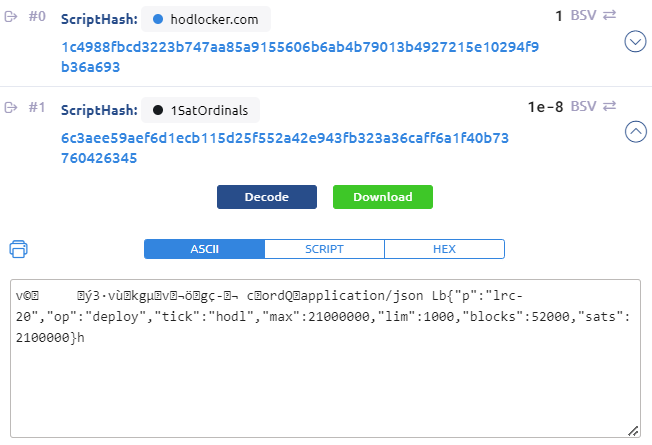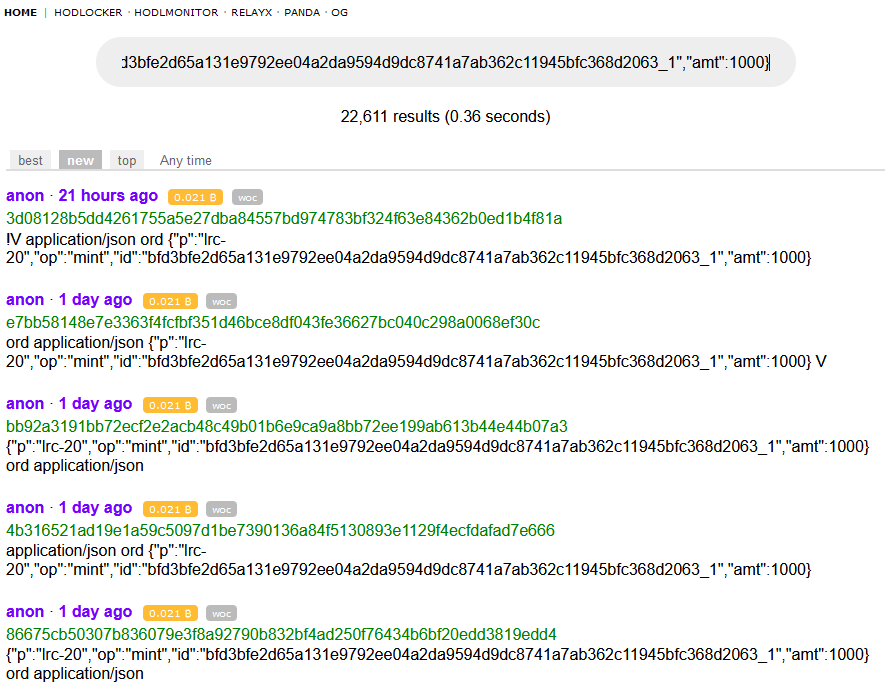
|
Getting your Trinity Audio player ready... |
Pseudonymous developer shrdlu2, who created hodlnet.sh released a specification on LRC-20, a token proposal that requires users to lock coins to mint according to the rules in the deployment transaction. This protocol is based on the BRC-20 (on BTC) and BSV-20 (on BSV) released in 2023 and functions similarly. Within hours after the specification was released on GitHub, the first token adhering to the protocol was deployed, aptly named hodl. Inspecting the payload, we see that the deploy function is very similar to BSV-20, with two newly added fields for blocks and sats.
On-chain minter for hodl, the first LRC-20 token adhering to the spec by shrdlu2https://t.co/1PzuHmBabDhttps://t.co/TNIKFlH1lB
Use at your own risk, mint 1,000 hodl in exchange for 0.021 $BSV for 52,000 blocks (1 year)
— shua (@cryptoAcorns) December 4, 2023

In this case, hodl was deployed with a 21 million supply, but for mints of hodl to be valid, they must be accompanied by a lock of at least 0.021 BSV for 52,000 blocks (roughly one year). The token requires 21,000 mints of 0.021 BSV to fully mint out, a total of 441 BSV.
This specification is influenced by the open, first-is-first spirit of BRC-20, where these parameters are not actually enforced on-chain by Bitcoin script, but whose ruleset is up for users, developers, and infrastructure to interpret and follow. This trade-off grants more scalability as the transactions can be created freely by anyone in exchange for excessive mint transactions being invalid according to the protocol. For example, every mint action for hodl after the 21,000th mint is invalid and will not grant tokens. However, this is a slight benefit over BRC-20, where the user loses their BTC to the miners (the transaction fee), whereas in LRC-20, the user locks coins for a year but can access them later.
To mint hodl, a simple on-chain minter was deployed as an inscription on the 1Sat Ordinals protocol using SHUAllet.js (a web browser wallet plugin that I developed). Users simply click to set up a wallet, back up their keys, send some BSV to the address, and start clicking. Upon clicking the mint button, users must specify their Ordinals address to receive the minted tokens. While LRC-20 is very similar to BSV-20, no wallet currently supports these tokens, so they look like strange JSON files inside whatever wallet holds them. Once a wallet does support them, they will function as other token wallets, such as Panda Wallet or RelayX, where balances are aggregated and transfers are handled appropriately.
Until then, the protocol specification advises not to send your mint inscriptions, as they may result in a burn. This detail differs from the original BRC-20 spec, which functions more like an account-based system where the initial minted tokens sit on the address they were minted to, regardless of what the owner does with the mint inscription.
While the mint was ongoing, users could search with the JSON payload of the mint and view real-time if hodl was minted out yet using hodlnet. This cool aspect added more excitement to the mint since users could ensure their mints were valid while also getting confirmation that others were participating as well.

Block 821,205 contained the 21,000th mint with a timestamp of 23:16 UTC. The first mint transaction was done in block 821,165 with a timestamp of 14:20 UTC, around 40 minutes after the announcement tweet, and in the same block as the post on hodlocker, proving a fair launch.
With just a simple specification and on-chain minter (with no styling or fancy UX), an exciting experience was created that did indeed draw newcomers into the BSV blockchain. Even with no secondary marketplace, indexer, or proper wallet support, people are still trading OTC, discussing hodl, and are interested in the next steps.
Watch: To build a blockchain business, you just need an idea
Recommended for you
Lorem ipsum odor amet, consectetuer adipiscing elit. Elit torquent maximus natoque viverra cursus maximus felis. Auctor commodo aliquet himenaeos fermentum
Lorem ipsum odor amet, consectetuer adipiscing elit. Accumsan mi at at semper libero pretium justo. Dictum parturient conubia turpis interdum

 11-21-2024
11-21-2024


